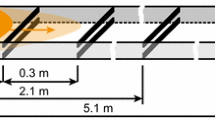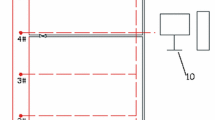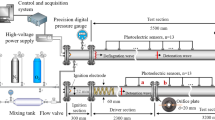Abstract
Detonation experiments are conducted in a 52 \(\hbox {mm}\) square channel with an ethylene–air gaseous mixture with dispersed liquid water droplets. The tests were conducted with a fuel–air equivalence ratio ranging from 0.9 to 1.1 at atmospheric pressure. An ultrasonic atomizer generates a polydisperse liquid water spray with droplet diameters of 8.5–12 \(\upmu \hbox {m}\), yielding an effective density of 100–120 \(\hbox {g}/\hbox {m}^{3}\). Pressure signals from seven transducers and cellular structure are recorded for each test. The detonation structure in the two-phase mixture exhibits a gaseous-like behaviour. The pressure profile in the expansion fan is not affected by the addition of water. A small detonation velocity deficit of up to 5 % was measured. However, the investigation highlights a dramatic increase in the cell size (\(\lambda \)) associated with the increase in the liquid water mass fraction in the two-phase mixture. The detonation structure evolves from a multi-cell to a half-cell mode. The analysis of the decay of the post-shock pressure fluctuations reveals that the ratio of the hydrodynamic thickness over the cell size (\(x_{{\mathrm {HT}}}/{\lambda }\)) remains quite constant, between 5 and 7. A slight decrease of this ratio is observed as the liquid water mass fraction is increased, or the ethylene–air mixture is made leaner.











Similar content being viewed by others
References
Cramer, F.B.: The onset of detonation in a droplet combustion field. In: Symposium (International) on Combustion, vol. 9, pp. 482–487. Elsevier (1963)
Dabora, E.K., Ragland, K.W., Nicholls, J.A.: Drop-size effects in spray detonations. In: Symposium International on Combustion, vol. 12, pp. 19–26 (1969)
Raglands, K.W., Dabora, E.K., Nicholls, J.A.: Observed structure of spray detonations. Phys. Fluids 11(11), 2377–2388 (1968)
Bar-Or, R., Sichel, M., Nicholls, J.A.: The propagation of cylindrical detonations in monodisperse sprays. In: Symposium (International) on Combustion, vol. 18, pp. 1599–1606. Elsevier (1981)
Bar-Or, R., Sichel, M., Nicholls, J.A.: The reaction zone structure of cylindrical detonations in monodisperse sprays. In: Symposium (International) on Combustion, vol. 19, pp. 665–673. Elsevier (1982)
Papavassiliou, J., Makris, A., Knystautas, R., Lee, J.H.S., Westbrook, C.K., Pitz, W.J.: Measurements of cellular structure in spray detonation. Prog. Astronaut. Aeronaut. 154, 148–169 (1993)
Benmahammed, M.A., Veyssiere, B., Khasainov, B.A., Mar, M.: Effect of gaseous oxidizer composition on the detonability of isooctane–air sprays. Combust. Flame 165, 198–207 (2016)
Mar, M.: Détonations dans les aérosols de gouttelettes de carburants liquides: étude de l’influence de la granulométrie des gouttelettes. PhD Thesis, ISAE-ENSMA, France (2012)
Ranger, A.A., Nicholls, J.A.: Aerodynamic shattering of liquid drops. AIAA J. 7(2), 285–290 (1969)
Fox, G.E., Dabora, E.K.: Breakup of liquid drops due to convective flow in shocked sprays. In: Symposium (International) on Combustion, vol. 14, pp. 1365–1373. Elsevier (1973)
Gelfand, B.E.: Droplet breakup phenomena in flows with velocity lag. Prog. Energy and Combust. Sci. 22(3), 201–265 (1996)
Law, C.K.: Recent advances in droplet vaporization and combustion. Prog. Energy Combust. Sci. 8(3), 171–201 (1982)
Carlson, L.W., Knight, R.M., Henrie, J.O.: Flame and detonation initiation and propagation in various hydrogen–air mixtures, with and without water spray. Technical report, Atomics International Division, Canoga Park, California (USA) (1973)
Mitani, T., Niioka, T.: Extinction phenomenon of premixed flames with alkali metal compounds. Combust. Flame 55(1), 13–21 (1984)
Sapko, M.J., Furno, A.L., Kuchta, J.M.: Quenching methane–air ignitions with water sprays. Technical report RI-8214, Department of the Interior, Bureau of Mines (1977)
Zalosh, R., Bajpai, S.: Water fog inerting of hydrogen–air mixtures. In: W.D. Nuclear Regulatory Commission (ed.) Workshop on the Impact of Hydrogen on Water Reactor, Albuquerque NM (USA), pp. 709–726 (1982)
Thomas, G.O., Jones, A., Edwards, M.J.: Influence of water sprays on explosion development in fuel–air mixtures. Combust. Sci. Technol. 80(1–3), 47–61 (1991)
Thomas, G.O.: On the conditions required for explosion mitigation by water sprays. Trans IChemE 78, 339–354 (2000)
Adiga, K.C., Willauer, H.D., Ananth, R., Williams, F.W.: Implications of droplet breakup and formation of ultra fine mist in blast mitigation. Fire Saf. J. 44(3), 363–369 (2009)
Willauer, H.D., Ananth, R., Farley, J., Williams, F.W.: Mitigation of TNT and Destex explosion effects using water mist. J. Hazard. Mater. 165(1), 1068–1073 (2009)
Laffitte, P., Bouchet, R.: Suppression of explosion waves in gaseous mixtures by means of fine powders. In: Symposium (International) on Combustion, vol. 7, pp. 504–508. Elsevier (1958)
Papalexandris, M.V.: Influence of inert particles on the propagation of multidimensional detonation waves. Combust. Flame 141(3), 216–228 (2005)
Fedorov, A.V., Kratova, Y.V.: Analysis of the influence of inert particles on the propagation of a cellular heterogeneous detonation. Shock Waves 25(3), 255–265 (2015)
Kauffman, C.W., Wolanski, P., Arisoy, A., Adams, P.R., Maker, B.N., Nicholls, J.A.: Dust, hybrid, and dusty detonations. Prog. Astronaut. Aeronaut. 94, 221–240 (1984)
Gerstein, M., Carlson, E.R., Hill, F.U.: Natural gas–air explosions at reduced pressure. Ind. Eng. Chem. 46(12), 2558–2562 (1954)
Thomas, G.O., Edwards, M.J., Edwards, D.H.: Studies of detonation quenching by water sprays. Combust. Sci. Technol. 71(4–6), 233–245 (1990)
Boeck, L.R., Kink, A., Oezdin, D., Hasslberger, J., Sattelmayer, T.: Influence of water mist on flame acceleration, DDT and detonation in H2–air mixtures. Int. J. Hydrog. Energy 40(21), 6995–7004 (2015)
Boeck, L.R., Katzy, P., Hasslberger, J., Kink, A., Sattelmayer, T.: The GraVent DDT database. Shock Waves (2016). doi:10.1007/s00193-016-0629-0
Ciccarelli, G., Ginsberg, T., Boccio, J., Economos, C., Sato, K., Kinoshita, M.: Detonation cell size measurements and predictions in hydrogen–air–steam mixtures at elevated temperatures. Combust. Flame 99, 212–220 (1994)
Best, A.C.: Empirical formulae for the terminal velocity of water drops falling through the atmosphere. Quar. J. R. Meteorol. Soc. 76(329), 302–311 (1950)
Victorov, S.B., Gubin, S.A., Maklashova, I.V., Revyakin, I.I.: Thermodynamic TDS code: Application to detonation properties of condensed explosives. In: 32nd Annual Conference of ICT. Energetic Materials. Ignition, Combustion and Detonation, pp. 69.1–69.15. Karlsruhe (2001)
Manzhalei, V.I.: Fine structure of the leading front of a gas detonation. Combust. Explos. Shock Waves 13(3), 402–404 (1977)
Shepherd, J.E.: Detonation: a look behind the front. In: International Colloquium on the Dynamics of Explosions and Reactive Systems, Hakone, Japan, pp. 218–233 (2003)
Desbordes, D., Presles, H.N.: Multi-scaled cellular detonation. In: Zhang, F. (ed.) Shock Waves Science and Technology Library, vol. 6, pp. 281–338. Springer, Berlin (2012)
Bull, D.C., Elsworth, J.E., Shuff, P.J., Metcalfe, E.: Detonation cell structures in fuel/air mixtures. Combust. Flame 45, 7–22 (1982)
Knystautas, R., Guirao, C.M., Lee, J.H.S., Sulmistras, A.: Measurement of cell size in hydrocarbon–air mixtures and predictions of critical tube diameter, critical initiation energy, and detonability limits. Prog. Astronaut. Aeronaut. 94, 23–37 (1984)
Kaneshige, M., Shepherd, J.E.: Detonation database. Technical report FM97-8, GALCIT. http://shepherd.caltech.edu/detn_db/html/db.html (1997). Accessed 15 July 2016
Browne, S., Ziegler, J., Shepherd, J.E.: Numerical solution methods for shock and detonation jump conditions. Technical report FM2006, GALCIT (2004)
Shepherd, J.E.: Chemical kinetics of hydrogen–air–diluent detonations. Prog. Astronaut. Aeronaut. 106, 263–293 (1986)
Goodwin, D.: Cantera: object-oriented software for reacting flows. http://www.cantera.org (2005). Accessed 15 July 2016
Smith, G.P., Golden, D.M., Frenklach, M., Moriarty, N.W., Eiteneer, B., Goldenberg, M., Bowman, C.T., Hanson, R.K., Song, S., Gardiner Jr, W.C., et al.: GRI-Mech 3.0. http://www.me.berkeley.edu/gri_mech (1999). Accessed 15 July 2016
Boeck, L.R.: Deflagration-to-detonation transition and detonation propagation in H2-air mixtures with transverse concentration gradients. Ph.D. thesis, Technische Universität München, München (2015)
Desbordes, D., Manson, N., Brossard, J.: Influence of walls on pressure behind self-sustained expanding cylindrical and plane detonations in gases. Prog. Astronaut. Aeronaut. 87, 302–317 (1983)
Soloukhin, R.I.: Multiheaded structure of gaseous detonation. Combust. Flame 10(1), 51–58 (1966)
Vasiliev, A.A., Gavrilenko, T.P., Topchian, M.E.: On the Chapman–Jouguet surface in multi-headed gaseous detonations. Astronaut. Acta 17(4), 499–502 (1972)
Weber, M., Olivier, H.: The thickness of detonation waves visualised by slight obstacles. Shock Waves 13(5), 351–365 (2003)
Lee, J.H.S., Radulescu, M.: On the hydrodynamic thickness of cellular detonations. Combust. Explos. Shock Waves 41(6), 745–765 (2005)
Edwards, D.H., Jones, A.T., Phillips, D.E.: The location of the Chapman–Jouguet surface in a multiheaded detonation wave. J. Phys. D: Appl. Phys. 9(9), 1331–1342 (1976)
Author information
Authors and Affiliations
Corresponding author
Additional information
Communicated by G. Ciccarelli.
Appendix
Appendix
This appendix highlights the process involved in filtering the raw pressure signals to estimate the experimental detonation pressure and the hydrodynamic thickness ratio. The timescale chosen is lower than 1 \(\hbox {ms}\) after the shock front arrival, to ensure a close-up selection on the post-shock zone pressure decay. The following filtering operations are applied to each pressure signal independently:
-
1.
A signal selection is first proceeded by removing the front shock to filter the post-shock signal.
-
2.
A fast Fourier transformation (FFT) is then applied on each pressure signal. To analyse and extract worthy information from the pressure signals, several considerations need to be kept in mind.
As suggested by Boeck [42], a natural mechanical influence generated by the pressure transducer itself generates pressure oscillations not related to the observed phenomenon. To remove this influence, a low-pass filtering with a cutoff frequency lower than 30 % of the natural transducer frequency was applied to the raw pressure signals. This implies a maximum frequency choice of 100 \(\hbox {kHz}\).
Frequencies larger than 20 \(\hbox {kHz}\) can be selected as they catch fluctuations related to phenomena smaller than a cell size. Indeed, the greatest detonation cell size obtained reaches approximately 80 \(\hbox {mm}\), therefore considering the associated detonation velocity of \(\approx \)1700 \(\hbox {m}/\hbox {s}\), a detonation characteristic frequency \(D/{\lambda }\) can be assessed, yielding approximately 21 \(\hbox {kHz}\).
Low frequencies ( \(20~\hbox {kHz}\)) are processed independently, as they capture the expansion wave characteristic frequencies.
-
3.
Considering the above analysis, a low-pass filter with a cutoff frequency of 5 \(\hbox {kHz}\) was used to estimate the experimental detonation pressure, as it is more suitable to select the expansion wave evolution in comparison with a 0–20 \(\hbox {kHz}\) low-pass filter.
A 20–100 \(\hbox {kHz}\) band-pass filter is applied to the decay of the pressure fluctuations behind the front shock to estimate the hydrodynamic thickness ratio. In both cases, the selected frequency bandwidths avoid the 12–14 \(\hbox {kHz}\) range containing frequencies inherent to the experimental setup visible on transducers C2–C4, as discussed in Sect. 3.3. This frequency range was also observed on the latter pressure transducers when the experimental apparatus was used in a shock tube configuration.
-
4.
An inverse Fourier transformation is applied on the filtered pressure signal, and a superimposition is performed for the same initial condition tests.
Rights and permissions
About this article
Cite this article
Jarsalé, G., Virot, F. & Chinnayya, A. Ethylene–air detonation in water spray. Shock Waves 26, 561–572 (2016). https://doi.org/10.1007/s00193-016-0679-3
Received:
Revised:
Accepted:
Published:
Issue Date:
DOI: https://doi.org/10.1007/s00193-016-0679-3




